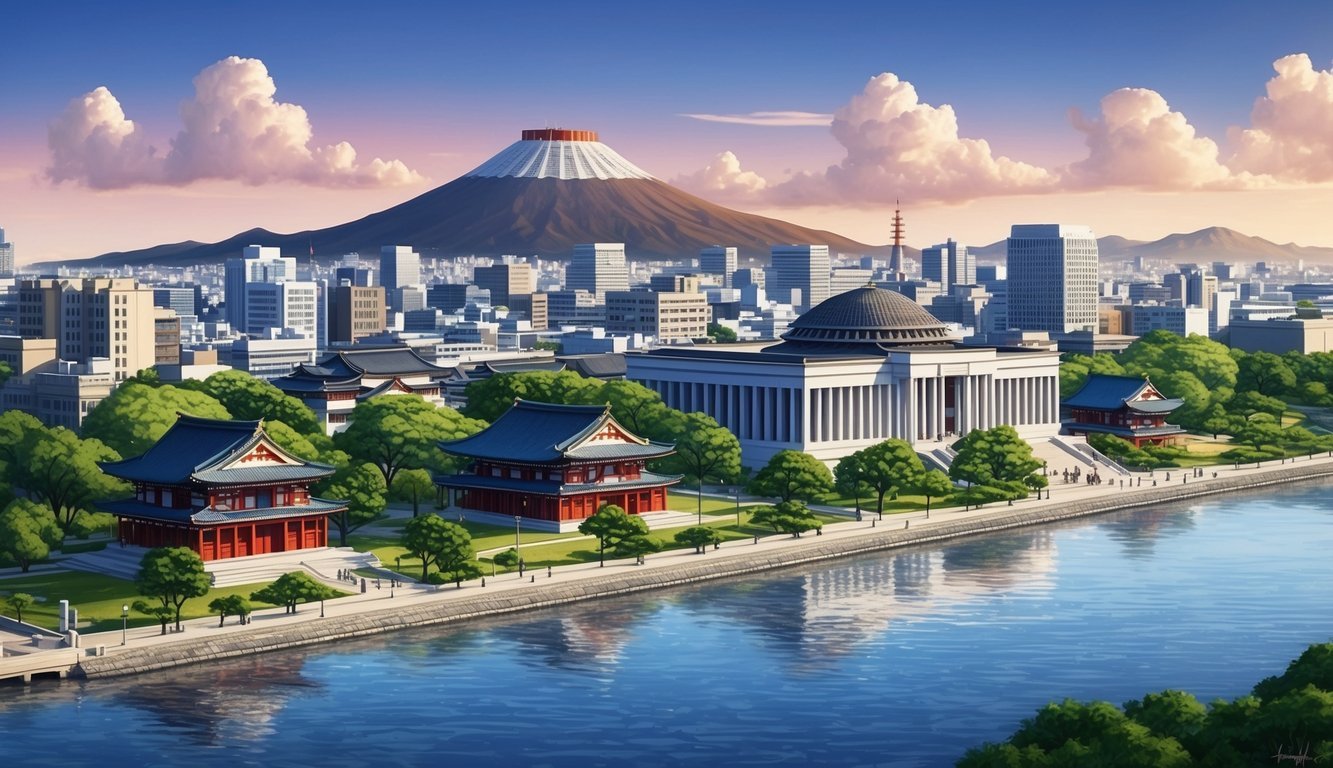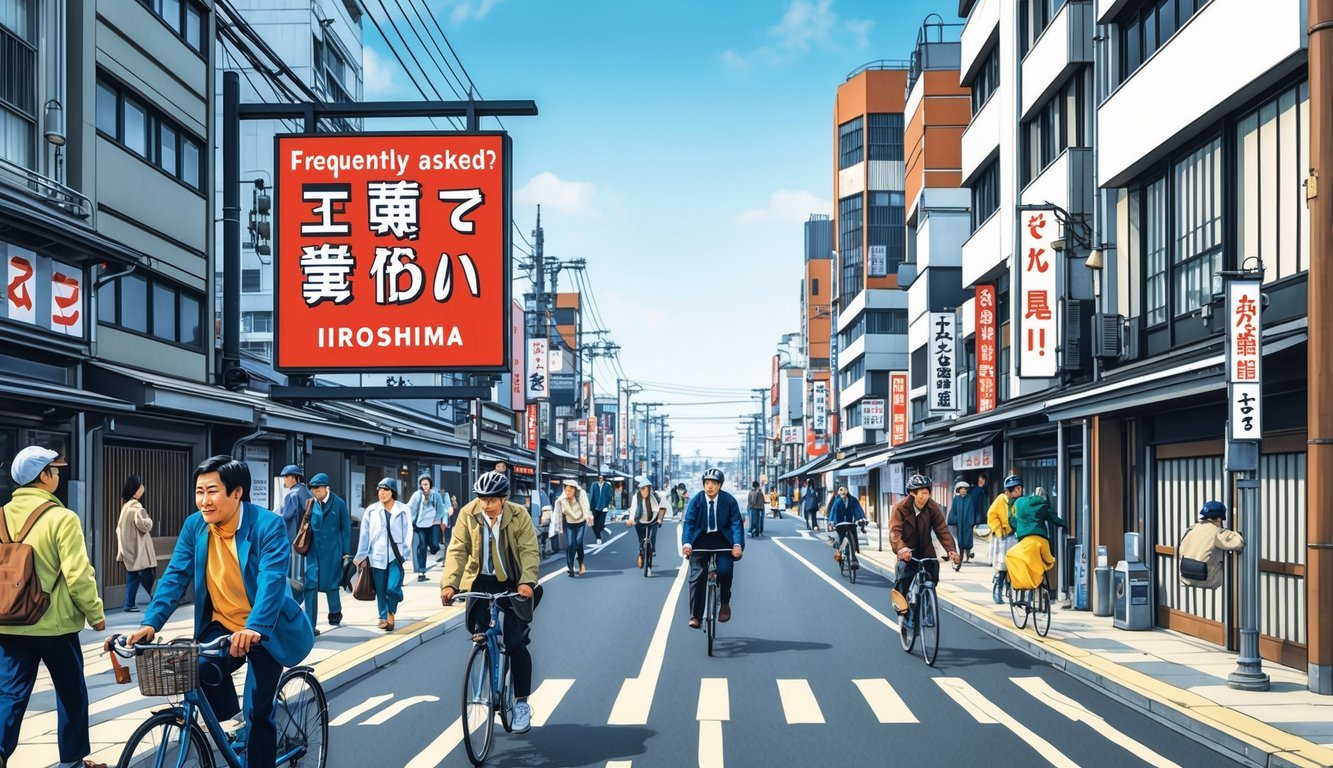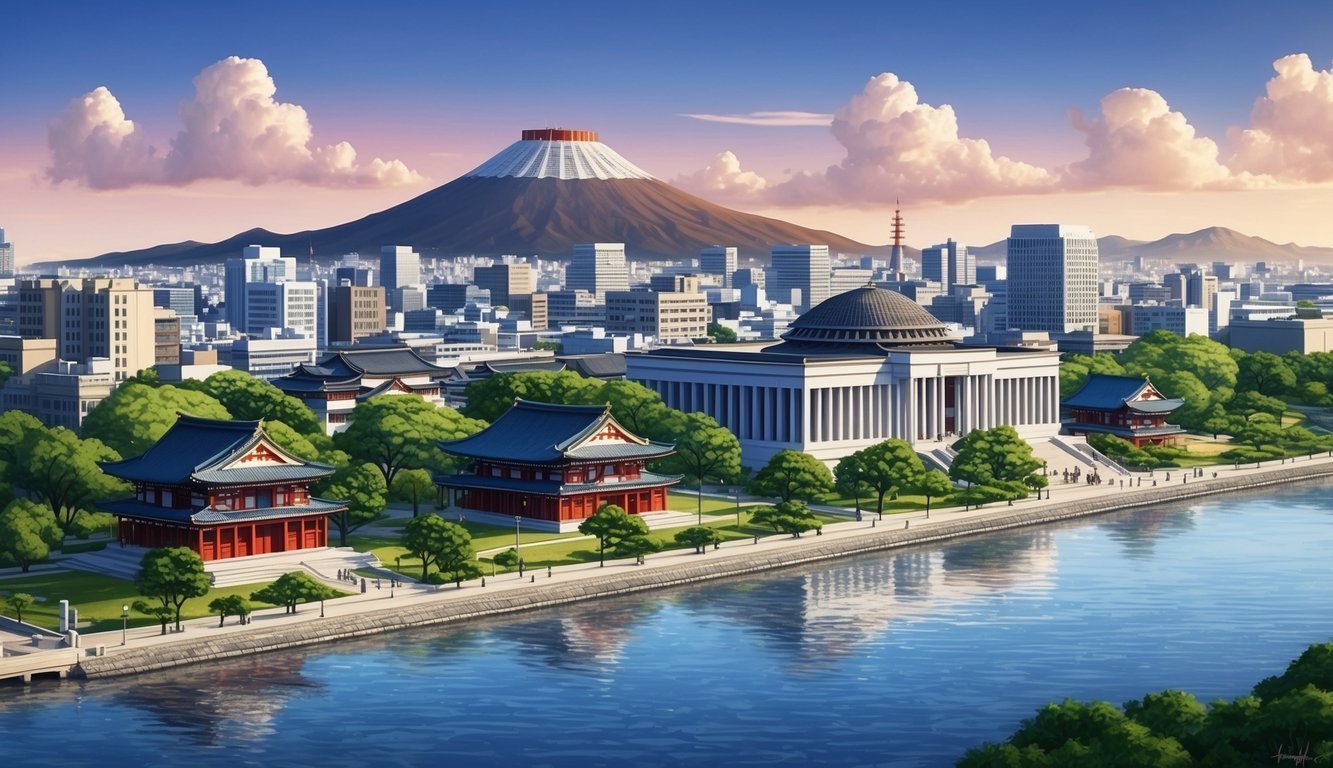Hiroshima, Japan, is a city that carries a powerful history while offering rich culture and beauty. This vibrant destination not only commemorates its past but also showcases stunning parks, delicious cuisine, and friendly locals.
Whether you’re taking in the serenity of the Hiroshima Peace Memorial Park or enjoying the flavors of Hiroshima-style okonomiyaki, there’s so much to explore.

Beyond its historical significance, Hiroshima is surrounded by breathtaking natural landscapes and outdoor activities.
From hiking in the nearby mountains to enjoying the pristine waters of the Seto Inland Sea, adventure awaits at every turn.
You’ll find that this city blends its cultural heritage with modern attractions, making it a unique place to visit.
As you plan your trip, consider what makes Hiroshima so special. It’s not just about the profound history; it’s the warmth of the people and the beautiful sights that will leave you inspired.
Your journey into this remarkable city promises unforgettable experiences.
Key Takeaways
- Hiroshima offers a mix of history, culture, and natural beauty.
- Outdoor activities and local cuisine enhance your visit.
- The city serves as a reminder of resilience and peace.
The Atomic Bombing of Hiroshima
The atomic bombing of Hiroshima on August 6, 1945, marked a pivotal moment in history.
This tragic event not only led to immense loss of life but also shaped the future of nuclear warfare and peace efforts worldwide.
Historical Context
During World War II, tensions escalated between Japan and the United States.
In an effort to end the war quickly, the U.S. dropped an atomic bomb named Little Boy on Hiroshima.
The attack resulted in immediate devastation, killing an estimated 80,000 people instantly, with total casualties reaching between 150,000 and 246,000 due to injuries and radiation over time.
This act aimed to force Japan’s surrender, which it did on August 15, 1945.
The bombing not only changed the course of the war but also sparked global discussions about nuclear weapons and their impacts.
Peace Memorial Park and Museum
After the bombing, Hiroshima began to rebuild, and in 1954, the Hiroshima Peace Memorial Park was established.
This park commemorates the victims and promotes a message of peace.
At its heart is the Atomic Bomb Dome, one of the few structures left standing after the blast.
It was designated a UNESCO World Heritage Site in 1996.
The Hiroshima Peace Memorial Museum is located within the park and offers insights into the bombing’s aftermath.
Exhibits include personal stories of survivors known as Hibakusha, photographs, and artifacts, all serving to educate visitors about the horrors of nuclear warfare.
Effects and Recovery
The effects of the bombing were far-reaching.
Many survivors suffered from severe injuries and long-term health issues due to radiation exposure, leading to ongoing studies by the Radiation Effects Research Foundation.
Hiroshima’s recovery is an inspiring tale of resilience.
The city transformed itself into a symbol of peace and hope.
Annual memorials and events celebrate the memory of victims while advocating for disarmament and a world free from nuclear weapons.
Cultural Landscape
Hiroshima offers a unique cultural landscape shaped by its history and local traditions.
The city’s vibrant food scene and diverse arts environment reflect this blend of heritage and modernity.
Food Scene
When in Hiroshima, you’re in for a treat with its local cuisine.
The city is famous for its Hiroshima-style okonomiyaki, a savory pancake layered with noodles, vegetables, and various toppings.
Unlike its Osaka counterpart, Hiroshima’s version builds flavors with careful stacking, making it a must-try.
You can find amazing versions of this dish at Okonomimura, a building full of stalls dedicated to okonomiyaki.
Another local favorite is momiji manju, sweet cakes shaped like maple leaves, often filled with red bean paste.
Don’t miss out on tsukemen, a dish served with dipping sauce, perfect for noodle lovers.
Arts and Museums
Hiroshima’s arts scene is just as captivating as its food.
Visit the Hiroshima City Museum of Contemporary Art to explore both Japanese and international artworks.
It features diverse exhibits that reflect the city’s resilience and creativity.
You can also enjoy the beauty of cherry blossoms in the parks and gardens.
A stroll through a traditional Japanese garden offers a serene escape, showcasing beautiful landscapes.
This blend of nature and art makes Hiroshima a special place to connect with culture.
Natural Beauty and Outdoor Activities
Hiroshima offers a mix of stunning natural beauty and exciting outdoor activities.
From the historical charm of Miyajima Island to scenic hikes and water adventures, there’s something for everyone to enjoy.
Miyajima Island
Miyajima Island is a must-visit spot just a short ferry ride from Hiroshima.
This beautiful island is famous for the Itsukushima Shrine and its iconic floating torii gate.
The view of the gate during high tide is breathtaking.
While you’re there, take the time to explore the lush landscapes.
You can also encounter friendly deer roaming around.
Enjoy the famous momiji (maple leaves) during autumn for a colorful experience.
Don’t miss the chance to hike up Mount Misen for panoramic views of the Seto Inland Sea.
Hikes and Gorges
If you love hiking, you have plenty of options around Hiroshima.
Sandankyo Gorge offers stunning trails that wind through dense forests and past beautiful waterfalls.
This is a great place for a leisurely hike or a picnic amidst nature.
Nearby, Taishakukyo is another fantastic spot for hikers with its rugged cliffs and vibrant scenery.
Keep an eye out for the autumn leaves, as they create a spectacular backdrop for your adventure.
Whether you’re a beginner or an experienced hiker, these gorges provide paths for everyone.
Water Activities
Water enthusiasts will find plenty to do in Hiroshima’s coastal waters.
You can enjoy stand-up paddleboarding (SUP) in the tranquil Hiroshima Bay or take a relaxing kayak trip around Tomonoura.
The Seto Inland Sea is perfect for boating and fishing, offering stunning views of the surrounding islands and coastal landscapes.
Exploring the sea gives you a unique perspective of the area’s natural beauty.
Plus, you might spot some local wildlife while you’re at it!
Exploring Historic Hiroshima
Hiroshima is a city that beautifully marries history and culture.
You’ll find stunning landmarks and serene gardens, each with a story to tell.
Let’s delve into two significant aspects of Hiroshima’s historic charm.
Hiroshima Castle
Hiroshima Castle, also known as Carp Castle, is a must-see.
Originally built in the 1590s by Mōri Terumoto, it showcases traditional Japanese architecture.
The castle was destroyed in the atomic bombing of 1945 but was meticulously reconstructed in 1958.
Inside, you can explore a museum dedicated to Hiroshima’s history.
This includes exhibits on samurai culture and the castle’s importance before World War II.
The surrounding park, especially during cherry blossom season, offers a picturesque spot for walks.
You can spend a lovely afternoon here, soaking in the sights and imagining the past.
Don’t forget your camera—the views are incredible.
Traditional and Historical Sites
Hiroshima is home to other significant historical sites worth exploring.
Visit Mitaki-dera Temple, a peaceful place surrounded by nature.
Its lush greenery and beautiful sculptures create a calming atmosphere.
Another gem is Shukkeien Garden, a traditional Japanese landscape garden.
It’s perfect for a tranquil stroll, featuring ponds, teahouses, and seasonal flowers.
Nearby towns like Fukuyama and Onomichi also add to the experience.
Both are rich in culture and history, showcasing traditional temples and lovely coastal views.
Each of these spots provides a glimpse into Hiroshima’s rich heritage and offers a unique way to connect with its past.
Travel Essentials
When visiting Hiroshima, it’s important to sort out where you’ll stay and how you’ll get around.
The right accommodations and transportation options can make your trip much smoother.
Accommodations
Hiroshima offers a range of places to stay, from luxury hotels to cozy hostels.
If you’re looking for comfort, check out hotels near the Hiroshima Peace Memorial Park, which puts you close to important sites.
Consider booking a room at the GRAND BASE Hiroshima Peace Memorial Park, just a short walk from key attractions.
If you’re on a budget, there are also affordable hostels and guesthouses that offer a local experience.
Don’t forget to book ahead during busy seasons, especially around events like the G7 Summit.
Planning your stay in advance helps you find the best deals and ensures you have a place to relax after exploring.
Transportation Tips
Getting around Hiroshima is simple and efficient.
The city has a reliable public transit system, including trams and buses.
You might want to grab a Japan Rail Pass for unlimited travel on certain trains.
If you’re flying in, Iwakuni Kintaikyo Airport is the nearest, and you can reach the city center easily.
Renting a bike is a popular way to explore, with many bike rental shops available.
When visiting sites like the Mazda Museum, consider using local transport options or walking to enjoy the scenery.
Hiroshima is also quite walkable, allowing you to soak in the atmosphere as you navigate through shopping areas and nightlife spots.
Surrounding Attractions

Hiroshima is not just about its rich history; it also offers exciting nearby destinations and serene nature spots.
You’ll find plenty to explore that enhances your experience.
Nearby Destinations
Just a short trip from Hiroshima, you can visit Iwakuni, known for its famous Kintaikyo Bridge, a historic wooden arch bridge offering stunning views.
This charming city also has attractions like the Iwakuni Castle.
Further along, don’t miss Nagasaki, which is about a two-hour train ride away.
Here, you’ll discover the Peace Park and the Atomic Bomb Museum, similar to what you find in Hiroshima.
If you’re up for an adventure, take a ferry to Okunoshima Island, known as Rabbit Island.
It’s a quirky spot where you can interact with friendly rabbits and enjoy beautiful beaches.
Nature and Relaxation
For some fresh air, head to Sera Kogen Farm, a local farm with breathtaking views of the surrounding countryside.
It’s an excellent place for hiking and enjoying seasonal flowers.
Plus, you can savor some tasty locally produced foods.
If you want to unwind, try the natural hot springs near Hiroshima.
Relaxing in a hot spring while soaking in nature is the perfect way to recharge.
Finally, Mount Futaba provides hiking opportunities with scenic trails.
The summit offers panoramic views, especially beautiful during sunrise or sunset.
Enjoy the blend of nature and serenity while exploring these nearby attractions.
Frequently Asked Questions

Many people have questions about Hiroshima, especially regarding its history and current atmosphere.
Here, you’ll find important details about the atomic bombing, the city’s transformation, and safety for visitors today.
Why did the U.S. decide to bomb Hiroshima and Nagasaki?
The U.S. aimed to end World War II quickly.
They believed that dropping atomic bombs on these cities would force Japan to surrender.
Hiroshima was a major military center, making it a significant target.
What’s Hiroshima like today?
Today, Hiroshima is a vibrant city with memorials that honor the victims of the bombing.
It has rebuilt itself into a place of peace and resilience.
The city showcases both modern attractions and historical sites.
Is there still radiation in Hiroshima?
Radiation levels in Hiroshima today are considered safe for residents and visitors.
The city has undergone thorough research, and the environment has returned to normal levels.
When did the atomic bombing of Hiroshima take place?
The atomic bombing occurred on August 6, 1945.
This event marked a significant turning point in history and led to Japan’s eventual surrender.
Is it safe to visit Hiroshima these days?
Yes, Hiroshima is safe for tourists today.
The city welcomes visitors, offering various attractions and educational experiences about its past.
How many victims were there from the Hiroshima bombing?
The bombing and its aftermath caused around 140,000 people to lose their lives by the end of 1945.
This tragic event had a lasting impact on the city and the world.

